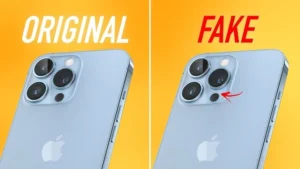

Counterfeit electronics are widespread in Kenya—from fake iPhones to knock-off TVs sold on Luthuli Avenue or social media marketplaces .
These pose risks like poor performance, no warranty, overheating, and electrical hazards . Recognising the signs saves money and ensures safety.
IMEI check: Dial *#06# and send the number to 1555. The Communications Authority (CA) will text back if the IMEI is valid, and if it matches the model
Serial/SM code (for appliances): Look for a KEBS Standardisation Mark and verify by SMS to 20023
High-quality packaging: Genuine products have tidy boxes, proper seals, and perfect print quality. Fake ones often show fuzzy logos, cheap materials, and missing certifications.
Watch for spelling errors: Typos or misaligned fonts on the box or manual are red flags.
Missing manufacturer info: No contact details or warranty cards? Be cautious.
Weight & materials: Genuine gadgets feel solid; fake ones are often light or made of cheap plastic.
Buttons & ports: Check for loose fitting, misaligned ports, or poor seam fitting .
Included accessories: Original items often come with branded chargers, cables, and paperwork. Fakes may skip certificates or include generic add-ons .
Operating system: Genuine phones run official OS smoothly. Counterfeits lag, freeze, or have fake menus.
Feature checks: Test camera clarity, battery consistency, GPS, connectivity. Poor results usually indicate fakes.
Model metadata: On iPhones, go to Settings > General > About. If the model number starts with F, it’s refurbished—M means new.
Too good to be true? If the price is under ~80% of retail, or suspiciously low, it’s likely fake.
Verify seller reputation: Buy only from authorized dealers, established shops, or top-rated online vendors.
Secure payment & receipts: Only proceed after receiving a proper invoice and warranty; avoid half-payment via Mpesa.
Watch for:
Logo inconsistencies like “Ulta” instead of “Ultra,” or misplaced fonts .
Screens that feel off: Fake devices often use low-res panels that display pixelation or washed-out colours .
Manual-language mismatch: Manuals in Chinese or poorly translated English are major red flags .

In Mombasa, CA seized over 5,000 fake phones in one raid .
A Kenyan buyer lost KSh 126,000 to a fake iPhone sold via Instagram—always buy from brick-and-mortar stores or authorized dealers .
KEBS frequently confiscates uncertified gadgets with only Chinese labels—always look for English/Kiswahili info and the SM mark .
IMEI check via *#06# → SMS to 1555 → confirm match
Inspect packaging, seals, and certificates
Feel the gadget’s quality—weight, fit, sturdiness
Test software, camera, connectivity, and GPS
Verify seller reputation and request a receipt
Compare labels, manuals, serial numbers
Trust your gut—don’t buy if anything seems off
100% Original product that covered warranty by the vendor.
You have the right to return your orders within 30 days.
Your orders are shipped seamlessly between countries
Your payments are secure with our private security network.

0712 939 925

